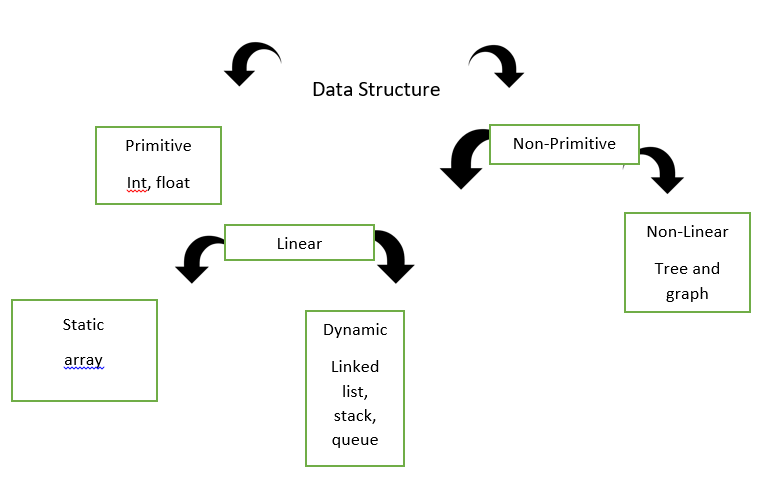Advantages and Disadvantages of Linked List Over ArrayLinked Lists and arrays are both the most useful data structures. Both have advantages and disadvantages; it completely depends on the situation in which data structure will be best to use by comparing their time and space complexity. Data StructureThe way of arranging and storing the data so that it is easy to access is called Data Structure. It serves as a container to store values in an efficient and manageable way. Classification of Data Structure: 
1. Primitive: These are the basic data structures used to derive other data structures. For example, int, float, String, etc. 2. Non-Primitive: These data structures are derived from primitive data structures. Non- Primitive data structures are categorized into two types:
The following operations help differentiate and find the advantages and disadvantages of the two data structures.
ArrayThe array is a type of data structure used to contiguously store different values in the memory. Arrays have a limited number of elements restricted by their size, which can be set while defining an array. 
A sample structure of an array is shown below: 
Indexing starts from 0 onwards. Types of Array1. One Dimensional Array It is the simplest form of an array. For example, Int arr[5] = {15,34,78,23,56}; 2. Two-Dimensional Array Generally, a two-dimensional array is a collection of one-dimensional arrays as an element. We can define a two-dimensional integer array with dimensions m x n and use it later in the code. We can create a 2-D array by giving the two values of rows and columns in the two-square brackets. For example, int arr[2][2]= {{2,6}, {6,2}}; You can assume it is a 2x2 matrix. 3. Multidimensional Array The array containing multiple dimensions is called a multidimensional array. We can create a 3-D array by giving the three values of three coordinates in the three-square brackets. For example, int arr[2][6][4]; Insertion: Inserting an element in the array at a specified position. It is beneficial to use an array for insertion at the last position if the space is free. Insertion in between or at the very first position in the array takes time and space. So we must not use an array for this type of insertion. Code for insertion in the array Deletion: Deleting an element from an array. For deletion, we must shift other elements, which is time-consuming. Searching: Search for an element in the given array. Searching in a sorted array is advisable rather than an unsorted array. Because the worst case of searching is the element at the last position, we must traverse the full array to reach the last position. Binary Search: In this searching algorithm, we always aim to reach the middle element by dividing the structure into two equal parts with the help of variables middle, low, and high. The values of high, middle, and low change in every division. The necessary condition to apply/use the Binary Search algorithm is that: The Data Structure should be sorted. If not, we must sort it. Sorting: Arranging the values in a logical order. Linked ListA linked List is also one among the linear data structures. A simple linked list structure contains the data section and the next section. The nodes are stored randomly in the primary memory space and are not necessarily contiguous. This is the main benefit of the Linked List, as it helps in better memory management. The data section stores the actual value/data. The next section stores the address of the next node. 
A sample structure of a linked list is shown below: 
Types of Linked Lists1. Singly-Linked List: It is a very simple type of Linked List with a linear structure with a data section and a next section. For Example: 
2. Doubly Linked List: Doubly linked list contains one extra part than the singly linked list, that is, the previous section along with data and the next. For Example: 
Code: 3. Circular Linked List: Circular linked List is a linked list that does not have any predefined starting and end. You can start from any node. We can say that a circular linked List is a singly linked list in which the next of the last node is pointing to the first node or head. For Example: 
Code: 4. Circular Doubly Linked List: It is a combination of a circular linked List and a doubly linked List. Let us understand it with an example: 
Sorting a Linked List Compare the data of the first node with the data present in each node. If the data of the first node is greater than the data of other nodes, swap the data of the first node and the data of other nodes. After iteration 1, the first node is sorted. Continue the same process for the second node to the last node. Code: Sorting through insertion sort:Code: Insertion in a Linked List Deletion in linked List Searching for the Data in a Linked List Applications of Linked ListUsed in implementing various other data structures like stack, queue, and graph. A real-life example based on the linked List is a rail-bogie system, in which bogies can be inserted anywhere in the chain. Advantages and Disadvantages of Linked ListAdvantages of Linked List
Disadvantages of linked List

Advantages and Disadvantages of the ArrayAdvantages of Array
Disadvantages of Array
One Can Prefer Linked List Over the Array in Below Mentioned Cases
|
 For Videos Join Our Youtube Channel: Join Now
For Videos Join Our Youtube Channel: Join Now
Feedback
- Send your Feedback to [email protected]
Help Others, Please Share









